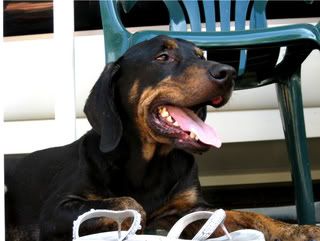Pat, I totally understand about not knowing where the line is between not enough correction and too much. I have the same problem myself.
I guess when we are first starting out it is trial and error. You need to first accept that you WILL make mistakes, ESPECIALLY if this is your first dog. Luckily for us clumsy humans, most dogs are very forgiving.
I suppose that your rule of thumb should be to correct only to the point of compliance. If you go back to the Basic Obedience video, Ed shows training the recall with his GSD pup by throwing some treats in the grass - i.e. the dog is distracted. He calls the dog then immediately pops it with the collar.
The dog's reaction will tell you everything about whether you did it right or not. If you did, it will react as Ed's dog does - jumps up and eagerly complies (ok, with hunting dogs it will be less eager). Too much and your dog will tuck its tail. You don't want a tucked tail and avoidance. A yip of surprise is OK the first one or two times, but the dog should immediately recover and realize what she is supposed to be doing. If you corrected too hard and the dog goes into avoidance, just go get the dog with a happy voice (don't reel her in) and take her inside - session over. Once inside play with her or feed her so she knows everything is OK. (Cockers are pretty tough though and I don't think you will have this problem).
If you didn't correct hard enough... then your dog will continue to ignore you as she has been.
You basically want the equivalent of "HEY! I called you so you better get your butt over here!" which is between a polite "oh please come, if you want to" and "YOU BAD BAD DOG!"
One thing I have done in the past is warn my dog I am going to pop him by sayng "no" before the pop. This has trained my dog that the actual command is "come - no" or "sit - no" i.e. he doesn't have to listen until I say no.
I hope other more experienced people will chime in also, as my dogs are far from perfect in the recall department.
One thing you may be interested in. In Ed's puppy video you will notice he states that he uses flexi-leads for puppies. That is probably the best advice I had ever heard, and I used one with my puppy. I found it was SOOOOOO much better than a long line because 1. it had a comfortable handle that did not hurt my hand and 2. it has BRAKES. I cannot tell you how many times brakes came in handy. With a long line, if your dog takes off running and hits the end you can hurt your arm (ask me about the scars on my hand). With a flexi that doesn't happen. Also it will never tangle. The downside to a flexi lead is that it teaches the dog to pull against the leash. I used a flexi lead in any situation requiring a long line (mine was 25 feet).
Here is the link to Ed's streaming video page (Warning! This page is like a vortex that will suck up your free time!
http://leerburg.com/videolist.php ).
 Previous Topic
Previous Topic Index
Index Next Topic
Next Topic











 . Go figure!!! I fear for her beautiful teeth but don’t know what to do. I guess I could force “out” command which she knows to spit out stuff by sticking my hand in her mouth to take it out. I have a luxury of doing that as she is a cocker whose jaw I can deal with. But, I’m not sure if that would make another my command less effective as it is associated with bad experience.
. Go figure!!! I fear for her beautiful teeth but don’t know what to do. I guess I could force “out” command which she knows to spit out stuff by sticking my hand in her mouth to take it out. I have a luxury of doing that as she is a cocker whose jaw I can deal with. But, I’m not sure if that would make another my command less effective as it is associated with bad experience. Top
Top




.jpg)